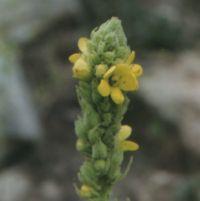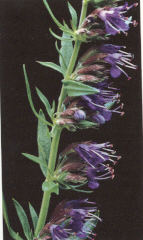 |
Mullein |
 |
Mullein |
By Molly Linton, N.D., L.M.
Otitis media, or inner ear infection, is the most common ailment affecting infants and toddlers. This condition is prevalent in small children because their ear canals are curved, facilitating infection. Most children outgrow ear infections since their ear canals straighten as they age.
Conventional treatment for otitis media includes antibiotics and ear tubes, both of which can cause health problems. However, natural therapies can be used to treat this condition without harmful side effects. If you think your child has an ear problem, see your doctor immediately. Chronic ear infections can lead to hearing loss.
The use of antibiotics can lead to bacterial imbalance in your child's intestinal tract. This in turn can result in illnesses including candidiasis and diarrhea. If your doctor prescribes antibiotics for an ear infection, give your child Lactobacillus acidophilus and L bifi- dus to reestablish bacterial balance in the digestive tract.
One danger of administering antibiotics for otitis media is possible overuse of this medicine. Often, because ear infections recur frequently, children must take antibiotics continuously for up to two years. This can lead to weakening of the immune system and the development of antibiotic-resistant organisms.
The American College of Pediatrics recently admitted the probable futility of antibiotic treatment for otitis media, recognizing that the infectious agent is most likely a viral infection that doesn't respond to antibiotics. The college has published articles indicating that routine use of antibiotics should be reserved for severe cases of ear infection.
Antibiotic Overuse May Cause Development Delays In Children A recent nationwide survey of 700 children ages 1 to 12 years has demonstrated a possible link between the overuse of antibiotics and developmental disorders in children. The survey, conducted by the Developmental Delay Registry in Silver Spring, Md., found that children who have taken more than 20 cycles of antibiotics in their lifetime are 50 percent more likely to experience developmental delays than children who haven't. Additionally, developmentally delayed children were 37 percent more likely to have had three or more ear infections than unaffected children. Kelly Dorman, a licensed nutritionist and cofounder of the Developmental Delay Registry, warns, "Parents should be put on notice that utilizing antibiotics prophylactically could jeopardize their children's development. We believe alternative approaches to treating ear infections should be considered." For more information, call: Developmental Delay Registry, (301) 652-2263. |
Frequently, antibiotic treatment fails, and many doctors recommend inserting ear tubes. This treatment can be dangerous, sometimes even resulting in death, because of the general anesthesia required during insertion of the ear tubes. Even if the operation goes well, the assault of anesthesia on a child's liver can stress that organ.
The basic cause of otitis media is a blockage of the eustachian tubes, the channel running from the inner ear to the back of the soft palates in our mouths. This leads to a backup of ear fluids. These ear fluids become a medium for bacterial infection. Fluid pressure and infection result in pain and inflammation.
The factors leading to blockage of the eustachian tubes include mucus, swelling of the gums, swelling of the mucous membranes, enlarged lymph nodes, and enlarged tonsils and adenoids. What leads to these conditions? Teething, colds, food allergies, airborne allergies and a depressed immune system.
Natural Therapies for Earaches
The natural treatment protocol for relieving otitis media is fourfold: relieve pain, remove the cause, prevent mucus formation and help the immune system.
Step 1: Pain relief is accomplished by reducing the swelling against the ear drum. Application of dry heat to the area such as with a heating pad or warm rock salt in a wool sock, herbal ear drops or acute homeopathic therapy may reduce the pain. Acute homeopathic therapy requires that you buy a homeopathic kit and guide book, usually available at your natural products store. The most common remedies for children include chamomilla, aconite and pulsatilla.
Step 2: Removing the cause of otitis media requires alleviating conditions that might lead to blockage of the eustachian tubes. Many ear infections occur when the child begins weaning from breastfeeding and food is introduced, resulting in food allergies or sensitivities. Cow's milk and other dairy products and sugar including fruit juices are known to cause food problems in children. Cow's milk is a common allergen and mucus-forming food. It's designed for an animal that has many stomachs to digest this heavy food. Sugar in any form reduces the child's white blood cell count for four hours, leading to susceptibility to infection. Lactating mothers should avoid these foods in their diets, as they're passed to their babies in mother's milk.
Step 3: The third step in preventing mucus formation and swelling often requires supplementing with nutrients that strengthen the cellular structure of the white blood cells to prevent them from breaking open and releasing histamines and prostaglandins. These substances are the biological components stimulating the inflammatory response. The strengthening of the white blood cell wall reduces the damage caused by both food allergens and environmental allergens such as animal dander and dust.
The most important nutrient is omega-3 fatty acids including flaxseed gill, fish oils and evening primrose oil. Cod liver oil is a good choice for omega-3 fatty acids because it contains vitamins A and D as well, which help boost the child's immune system. Omega-3 oils encourage the production of noninflammatory prostaglandins. Bioflavonoids (hibiscus, rosehips) and vitamin C (preferably buffered) may also help mitigate mucus.
Step 4: The fourth step is helping the immune system. Ear drops containing mullein, garlic and/or glycerin are analgesic as well as antimicrobial. Glycerin drops also draw water across the membrane, reducing fluid behind the ear. The drops are more effective and tolerated if they're warmed before application. The best time to apply drops is at night while the child sleeps. Clean the ear with a few drops of hydrogen peroxide in the morning. Echinacea, homeopathic remedies and betacarotene, taken internally, can also help enhance the child's immune system.

Hyssop
In addition to natural medicines, another useful therapy is a carrot poultice. A carrot is grated into a cheese cloth, which is wrapped around the child's throat, and a scarf is tied around the cheesecloth. This poultice is left in place for a minimum of 20 minutes to help reduce lymph gland swelling. If the child is old enough to gargle, salt water gargles may help clear the eustachian tubes as well.
Molly Linton, N.D., L.M, is a naturopathic physician and licensed midwife in private family practice in Seattle, Wash.
This article is produced through the Bastyr University Health Information Project, funded by INDENA, U.S.A., raw material suppliers of standardized herbal extracts. University offers a program in naturopathic medicine (N.D.); bachelor's degrees in the natural health sciences;. and master's degree programs in nutrition and acupuncture. For information, contact Bastyr University, 144 NE 54th St., Seattle, WA 98105, 206-523-9585.
Reprinted with permission from the December 1995 issue of Delicious! Magazine, a publication of New Hope Communications, Boulder, CO.